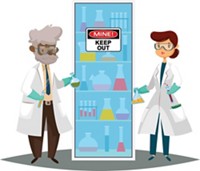Advertisement
Grab your lab coat. Let's get started
Welcome!
Welcome!
Create an account below to get 6 C&EN articles per month, receive newsletters and more - all free.
It seems this is your first time logging in online. Please enter the following information to continue.
As an ACS member you automatically get access to this site. All we need is few more details to create your reading experience.
Not you? Sign in with a different account.
Not you? Sign in with a different account.
ERROR 1
ERROR 1
ERROR 2
ERROR 2
ERROR 2
ERROR 2
ERROR 2
Password and Confirm password must match.
If you have an ACS member number, please enter it here so we can link this account to your membership. (optional)
ERROR 2
ACS values your privacy. By submitting your information, you are gaining access to C&EN and subscribing to our weekly newsletter. We use the information you provide to make your reading experience better, and we will never sell your data to third party members.
Education
What’s in your lab-coat pocket?
The things we carry around say a lot about what we do as chemists
by Chemjobber
August 20, 2017
| A version of this story appeared in
Volume 95, Issue 33
When I graduated from high school and started my first internship in a laboratory, I admired how prepared my fellow scientists were for their jobs. It wasn’t just their notebooks with the neat entries; it was how they carried their tools in their lab-coat pockets. Gloves, glove liners, pencils, grease pens, permanent markers, laboratory glasses, and other useful things would appear like magic in my mentors’ hands. Now that I have a few more years of laboratory work under my belt, I marvel at all the things I’ve got stuffed into my own lab-coat pockets, ready at a moment’s notice.
If you stopped 100 chemists and asked them what they carry around in their pockets, I’ll bet the most common answer would be the classic black marker. I remember someone saying to me during my internship, “You can’t do science without a black Sharpie.” And without a doubt, most lab-coat pockets have them. I suspect most people prefer the standard kind that works well for writing on laboratory tape or for labeling a round-bottom flask, but you can find folks who prefer the fine-tipped kind for writing in lab notebooks. If you’re someone who deals with a lot of powerful solvents, there are even smudge-proof permanent markers.
Heaven help you if the ink ends up on your lab coat, or worse, your hands. Of course, there are ways to avoid that, such as the super retro pocket protector (C&EN, Aug. 17, 2009, page 56). It’s common to see random stains from a stray permanent marker that either leaks or doesn’t quite get capped. Some chemists carry around retractable permanent markers, and it’s fun listening to the sound of two chemists discussing a difficult synthetic problem with a coworker while scribbling structures on a hood sash, rhythmically clicking their pens.
In my pockets, you will often find a silver permanent marker. It’s not often that I use it, but I have found it to be useful for writing on amber bottles, where a typical black permanent marker cannot be seen. When I use it, I think of my old graduate school classmate who taught me the value of these pens. I can still see his neat handwriting on top of old sec-butyllithium bottles, marking the date that they were opened.
After permanent markers, pipette bulbs have to be the most common item in a chemist’s pocket. I confess that I never enjoyed the process of searching around for them when I worked in my hood, so I would hoard them in my lab-coat pockets for pipetting solvents or taking reaction samples.
I’m also partial to multitools. They can be incredibly helpful. Most multitools have a little bit of everything: a screwdriver for the stray loose screw, pliers to twist copper wire to wire down Tygon tubing on condensers, a small knife to cut open that box of new chemicals, or a lever to pry open a recalcitrant plastic safety seal on cans that store reagents.
A useful item that I never expected to carry around in my pockets is a compact flashlight. Now that I work at a chemical plant, a flashlight is a fantastic tool for illuminating dark corners of the plant. Along with my hard hat, glasses, and steel-toed boots, a bright flashlight is a must-have, especially when tracing the route of pipes to be used for distillation with plant operators. Flashlights are useful in the laboratory as well. Want to see particulates in a flask? Put a flashlight on one side of the reactor and look in the other side; fine particles will show up very nicely. It’s also a great tool for peering into the nooks and crannies of an instrument.
And then there are the things we put in our pockets to rescue us in a pinch. During my internship, in which I was introduced to the laboratory coat and all its trappings, one of the supervisors had a habit of long conversations that would eat up a lot of time and lengthen already time-intensive procedures. We also had these ridiculously large hand-cranked timers that would emit a loud ring when they went off. One of the technicians carried one of these timers in her pocket, and if the supervisor went on for just a little too long, the chemist would surreptitiously wind up the timer, and the loud ringing (ostensibly calling her to the next step in her experiment) would release her from the boss’s monologue.
The things we put in our pockets are a reflection of our training, the people we’ve worked with, the kind of chemistry we do, and what we find necessary and useful to us in the laboratory. Perhaps the next time you’re in the lab chatting with coworkers, you might ask them, “What’s in your lab-coat pockets?”
Chemjobber is an industrial chemist who blogs about the chemistry job market at chemjobber.blogspot.com. Find all his columns for C&EN and suggest future topics at cenm.ag/benchandcubicle.
Views expressed are those of the author and not necessarily those of C&EN or ACS.







Join the conversation
Contact the reporter
Submit a Letter to the Editor for publication
Engage with us on Twitter